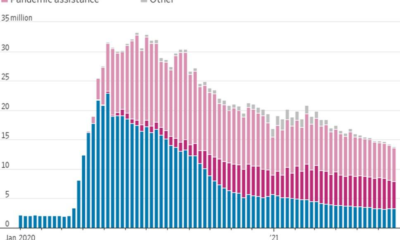Money
Consultancies are coming off a pandemic boom. Are they still worth hiring?

They’re the go-to people in every crisis, and they’ve boomed in recent years. Management consultancies helped design vaccination programs during the pandemic and are currently providing advice on how to rescue one of the world’s biggest banks.
But they’re now in retreat as the economy slows, laying off thousands of people, and facing renewed criticisms about some of their work and the impact they have on the ability of governments and companies to solve their own problems.
The $230 billion management consulting industry is a broad church: it includes companies offering everything from project management expertise to designing new organizational structures. Within that, strategy consultants offer clients their take on how to build and improve their organizations.
Many big firms — think EY and KPMG — also conduct audits and advise on their clients’ tax issues, though these services are generally seen as distinct from their consulting work.
Last week, the Swiss government awarded a contract worth 8.7 million Swiss francs ($9.8 million) to Alvarez & Marsal Switzerland, a management consultancy, to help with aspects of the emergency takeover of Credit Suisse by its bigger rival UBS.
But this type of professional problem-solver has come under strong criticism as of late.
In The Big Con, published in February, prize-winning economist Mariana Mazzucato and her co-author Rosie Collington argue that management consultancies “infantilize” governments by keeping them dependent on their services.
National administrations have “become reliant on consultants, and the problem is the consultants take advantage of that,” the University College London professor told CNN. “They have no incentive to make governments better; otherwise they won’t get a future contract.”
Officials farm out some of their most interesting work to consultants who, she argues, often lack the necessary skills and experience to do it well.
“Governments have stopped investing in their own brains,” Mazzucato said. “They’ve become… inertial, not very capable, because they don’t invest in their own capacity.”
The professor, who also advises policymakers around the world, reserves much of her ire for the United Kingdom — a key provider of public and private sector work for consultancies, although the United States, Canada, France and Germany are also big markets.
Many of the criticisms are not exactly new. The stereotype of the overpaid and underqualified consultant advising an organization on how to cut costs (read: headcount), or simply rubberstamp a decision it has already made, has long hung over consulting firms like McKinsey & Company and Boston Consulting Group.
An article published in 2013 in the Harvard Business Review noted that “consulting has long inspired some degree of the-emperor-has-no-clothes skepticism,” citing books such as The Witch Doctors and The Management Myth.
Even so, demand for consultants’ services grew last year, with overall revenue up 10.7%, according to Source, a consulting sector think-tank.
The global consulting industry also enjoyed an “exceptional” period of growth in the wake of the pandemic, said Fiona Czerniawska, chief executive of Source. Between late 2020 and the first half of 2022, companies and governments hired consultants to work on a glut of new projects while many of their own staff were off sick.
Money
Where Tech Talent Goes To Thrive

here is a worldwide shortage of digital skills. In a world increasingly reliant on technology, demand for technological skillsets is rising by as much as 50%. Meanwhile, nearly three-quarters of today’s workers don’t feel equipped to learn the digital skills needed by businesses.
The most acute shortage is in advanced skills like programming, especially for new technologies like AI and blockchain.
This demand gives skilled tech workers, entrepreneurs, and leaders the pick of where to base themselves. As cities and nations compete to attract tech talent, what makes these prized individuals choose one place over another?.
Initial Attraction
In a survey of ‘tech migrants’, Boston Consulting Group identified a mixture of short-, medium-, and long-term levers businesses and cities could use to attract talent.
The initial attraction is often brute economics: higher pay and lower taxes. That’s certainly what brings people to Dubai, says Vladimir Vrzhovski, Tech and Digital Lead at Mercer: “Dubai pays about 30% higher than most of the mature tech hubs around Europe and Asia.” It also has a lower cost of living, especially when its 0% income tax is taken into account.
Businesses operating in the city’s free zones – like the tech-focused Dubai Internet City (DIC) and Dubai International Finance Centre (DIFC) Innovation Hub – also benefit from 0% corporation tax. BCG credits the incentive with bringing big names like Amazon, Google, and Oracle to the emirate.
It is an echo of London’s rise to tech prominence, offering tax relief on tech investments via its Seed Enterprise Investment Scheme (SEIS) to funnel the city’s vast pools of finance towards digital businesses.
The presence of blue-chip names affords another major draw for tech talent: opportunities.
Money
Adding exercise into treatment may reduce substance use, study shows

One key to fighting addiction may be exercise, according to a new study.
Researchers undertook a review of the existing literature around physical activity and its relationship to substance use, and they found that regular exercise was associated with lowered use in about 75% of the studies investigating that question, according to the analysis.
The review, published Wednesday in the journal PLOS ONE, looked at 43 studies with more than 3,000 total participants. In addition to a reduction or cessation in substance use, the studies also found improved markers of physical health and decreased depressive symptoms, the study said.
“People think that during treatment people should only do psychotherapeutic treatments … but that’s not what we’ve seen in our study,” said lead study author Florence Piché, a doctoral student and researcher at Université de Montréal in Canada. “It’s very beneficial to do physical activity in addition to the treatments.”
There are limitations to the findings. The review found that most of the studies the researchers examined had a high risk of bias, meaning more research is needed to confirm their findings, said Dr. Aaron Kandola, research fellow at Medical Research Council Unit for Lifelong Health and Ageing at University College London.
The studies were also not directly comparable enough to build a comprehensive and generalizable understanding of the relationship, Kandola said in an email. Kandola was not part of the research.
However, the findings were still significant and useful, he added.
“Substance use disorders are a major public health problem lacking low-cost, evidence-based solutions,” he said, adding that substance use disorders are worsening in many high-income countries — including the United States.
Finding more accessible solutions to this disorder is especially important because it often occurs with other mental health problems such as depression and anxiety, which disproportionately affect people with fewer socioeconomic resources and areas with higher deprivation, he said.
Physical activity may be a useful and accessible part of a treatment plan for substance use disorder, said Dr. Mark Smith, professor of psychology at Davidson College in North Carolina. Smith was not part of the research.
“I think there’s now a sufficient amount of data to indicate that various forms of physical activity and exercise are generally effective at reducing substance use in individuals seeking treatment,” he said.
What exercise does
Most people can benefit from engaging in physical activity, Kandola said.
One benefit the studies found is improvements in physical health such as cardiovascular endurance or muscle strength, Smith said. And although that may not be the primary goal of the research, he said this finding is important because it shows the physical activity is doing its job to promote physical health.
Money
Blood sugar drug tirzepatide also leads to substantial weight loss in diabetes patients, Eli Lilly says

There’s more evidence that the injectable drug tirzepatide helps people with diabetes lose weight as well as control their blood sugar, according to the drug’s manufacturer, Eli Lilly and Company.
In a new study, more than 900 adults with obesity and diabetes took the drug for a year and five months, and those on the highest dose lost an average of 34 pounds, or nearly 16% of their starting weight. It also helped people reduce their blood sugar, the company said in a news release. The data has not yet been peer-reviewed or published in a medical journal.
“We have not hit 15% in any other phase three trial for weight management in this type two diabetes population,” said Dr. Nadia Ahmad, an associate vice president at Eli Lilly and medical director of obesity clinical development for the company.
Ahmad said the company was pleased with these results, given how hard it is for people with type 2 diabetes to lose weight.
Tirzepatide is currently sold as Mounjaro and approved to help people with type 2 diabetes control their blood sugar.
Lilly says it will use the new study, along with results from an earlier study of weight loss in people without diabetes, to ask the US Food and Drug Administration to fast-track approval for tirzepatide purely for weight loss, which would make it a direct competitor to the blockbuster obesity drug Wegovy.
Plenty of people aren’t waiting for the FDA’s nod.
“I am aware of and I’ve heard, you know, it being sort of used off label for weight loss and individuals who do not have diabetes,” said Dr. Kimberly Gudzune, medical director of the American Board of Obesity Medicine. Gudzune was not involved in the tirzepatide study.
Gudzune points out that once a drug is FDA approved it can be prescribed for any reason a doctor sees as medically necessary.
Tirzepatide, along with several similar types of drugs taken for diabetes, went into shortage last year as success stories posted on social media fueled runaway demand for their weight loss benefits. The shortages made the medications difficult for patients with diabetes to get.
Tirzepatide works by mimicking the action of two different gut hormones. When blood sugar rises after eating, the drug stimulates the body to produce more insulin, which lowers blood sugar. It also slows down the movement of food from the stomach, making people feel fuller for longer. In clinical trials, people who took tirzepatide experienced more nausea, vomiting and diarrhea compared with those who took a placebo injection.
Semaglutide, manufactured by Novo Nordisk, has also been approved as a weight loss medication for overweight adults with at least one associated health problem since 2021. When prescribed for weight loss, it is sold under the brand name Wegovy. When prescribed for diabetes, the injection is sold under the brand name Ozempic.
High demand, coupled with manufacturing problems, threw Wegovy into shortage for much of the last year. That shortage then rippled into shortages for diabetes patients as doctors began prescribing other diabetes medications off-label for weight loss.
There has already been a lot of buzz about tirzepatide’s potential as an obesity medication. In a clinical trial published in the New England Journal of Medicine last year, people who were overweight or obese, but did not have diabetes, lost an average of 52 pounds on the highest dose of the drug, or more than 20% of their starting weight.
“In the last year has been really exciting just to have more tools in the toolbox, so to speak. And tools that, you know, we’re seeing really achieving outcomes that patients for the longest time have been hoping to achieve,” Gudzune said.
If those results hold up in the real world, that would make it the most potent of the injectable weight loss medications.
Indeed, this week Lilly aims to begin a study that will test Mounjaro against Wegovy head-to-head in 700 participants at 61 sites in the United States and Canada, according to clinicaltrials.gov. The study will conclude in February 2025.
-

 Business3 years ago
Business3 years agoHyundai Leads Industry in U.S. News & World Report 2023 Best Cars for the Money Awards
-

 Innovation3 years ago
Innovation3 years agoJay-S ventures into the urban genre with “Bailar en la Playa” his latest production
-

 Business3 years ago
Business3 years agoThree Questions Small Business Owners Should Ask In Creating A Workplace Culture – Forbes
-

 Business3 years ago
Business3 years agoA Fintech Makes It Easy For Small Businesses To Offer 401(k) Retirement Benefits – Forbes
-

 Business3 years ago
Business3 years agoBritain’s Small Businesses See Better Times Ahead But Is Their Optimism Justified? – Forbes
-

 Money3 years ago
Money3 years agoCharlie Crist leads Democratic gubernatorial field again in money chase – Florida Politics
-

 Money3 years ago
Money3 years agoTesting New Tools for Horizon Worlds Creators To Earn Money
-

 Business3 years ago
Business3 years agoSmall Business Labor Shortage – Forbes
